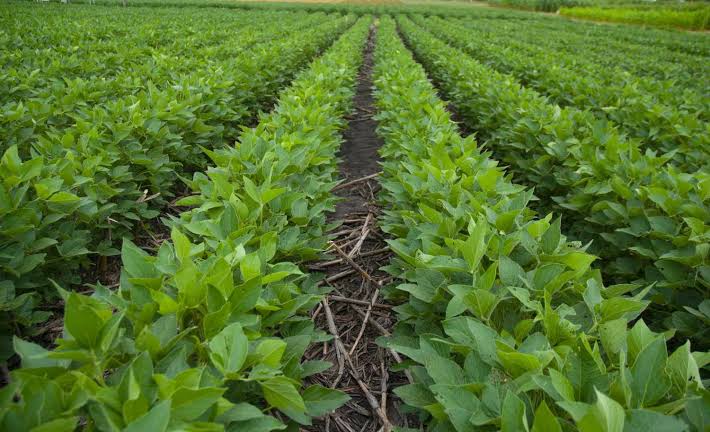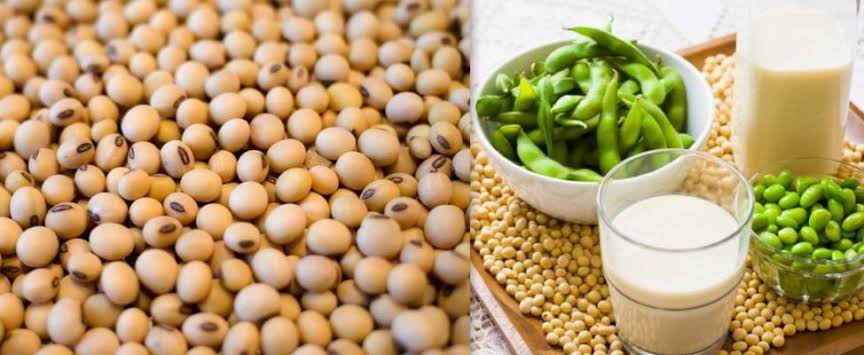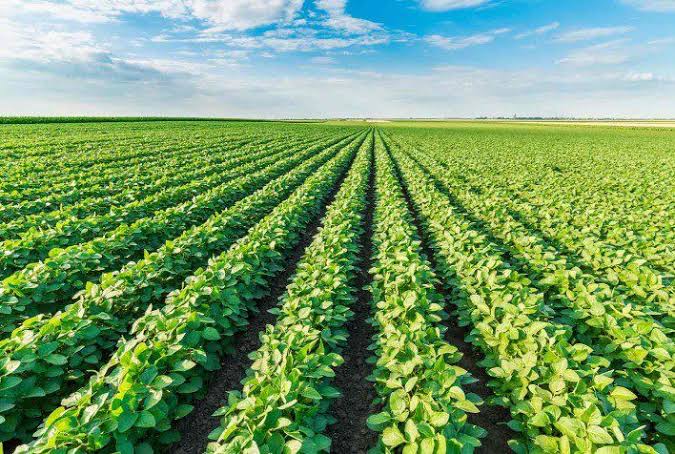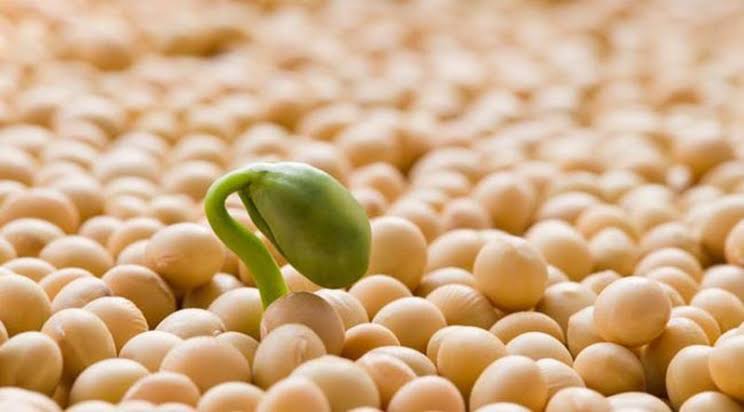Soybeans is a special kind of plant that people use for many things. It grows in fields and has small beans that are really useful. People have been using soybeans for a very long time, and they have discovered many great things about them.
One cool thing about soybeans is that they are packed with protein. Protein is like the building blocks for our bodies, helping us grow strong and stay healthy. So, when we eat soybeans or foods made from them, we get a good dose of this important stuff.
Not just that, soybeans are also used to make different types of yummy foods. Tofu is one of them. It’s made from soybeans, and some people really love it. Tofu can be cooked in many ways – fried, grilled, or even put in soups. It’s like a chameleon that can take on different flavors depending on how it’s cooked.
But wait, there’s more! Soybeans are not just for eating; they can also be turned into things we use every day. Have you ever worn clothes made of soft fabric? Chances are, that fabric might have come from soybeans. People have figured out how to turn soybeans into fibers to make clothing that feels nice against our skin.
And it doesn’t stop there. Soybeans are like little magicians that can also become oil. This oil can be used for cooking, making things like salad dressings, and even in products like soap. So, soybeans are not just good for our bodies but also for making our daily lives a bit easier.
Farmers around the world grow soybeans because they’re so versatile. They help feed people, provide materials for things we use, and even contribute to making the air cleaner. That’s right – soybeans can help the environment too. They can take in the bad air and give back good air for us to breathe.
Soybeans are like superheroes in the plant world. They give us protein for strong bodies, tasty foods to enjoy, materials for clothing, and even help keep the environment healthy. So, the next time you see a field of soybeans, remember all the amazing things these little beans can do!
Farmers play a crucial role in the soybean story. They carefully plant the soybean seeds in the soil, providing them with just the right amount of water and sunlight. As the soybeans grow, the farmers tend to their fields, making sure the plants are healthy and ready for harvest.
When the time is right, farmers gather the soybeans from the fields. This is an important moment because it marks the culmination of months of hard work. The soybeans are then sent to various places where they will be transformed into the products we use every day.
In addition to being a versatile and nutritious crop, soybeans also contribute to sustainable farming practices. Some farmers use a method called crop rotation, where they alternate soybeans with other crops. This helps keep the soil healthy and fertile, ensuring that it can continue to support plant life for years to come.
Moreover, soybeans have a unique ability to fix nitrogen in the soil. This means they can take nitrogen from the air and make it available to other plants, promoting a healthier ecosystem. It’s like soybeans are not just benefiting themselves but also lending a helping hand to the other plants around them.
Soybeans have become an essential part of global agriculture and economies. Countries around the world grow and trade soybeans, making it a valuable crop on the international stage. This interconnectedness shows how something as simple as a soybean can have far-reaching impacts on people’s lives worldwide.
The story of soybeans is one of versatility, sustainability, and global significance. From their humble beginnings as seeds in the soil to their transformation into a wide array of products, soybeans have woven themselves into the fabric of our daily lives. As we enjoy the benefits of soy-based foods, clothing, and more, let’s also appreciate the hard work of the farmers and the remarkable journey of these tiny beans.
Read Also: Guide To Your Rabbit Housing Requirements
How to Grow and Care for Soybeans

Growing and caring for soybeans can be a rewarding experience. Here’s a simple guide to help you cultivate healthy soybean plants:
1. Planting:
Select a Suitable Location: Choose a sunny spot with well-draining soil for your soybeans. They thrive in areas with full sunlight.
Prepare the Soil: Soybeans prefer slightly acidic to neutral soil. Test the soil and, if needed, amend it with organic matter like compost.
Sowing Seeds: Plant soybean seeds directly in the soil after the last frost. Space the seeds about 2-4 inches apart and 1-1.5 inches deep.
2. Caring for Soybeans:
Watering: Keep the soil consistently moist, especially during flowering and pod formation. Water at the base of the plants to avoid wetting the leaves, which can lead to diseases.
Fertilizing: Soybeans are nitrogen-fixing plants, meaning they can extract nitrogen from the air. Additional fertilization may not be necessary if the soil is well-balanced. However, you can provide a balanced fertilizer if the plants show signs of nutrient deficiency.
Weeding: Regularly remove weeds around your soybean plants, especially when they are young. Weeds compete for nutrients and water, which can affect the soybeans’ growth.
Support if Needed: Depending on the variety and growing conditions, soybean plants may benefit from support. Some varieties are bushy and may not require support, while others might benefit from stakes or cages.
3. Pest and Disease Management:
Monitor for Pests: Keep an eye out for common pests like aphids, bean beetles, and caterpillars. If you notice an infestation, consider using organic methods or insecticidal soap.
Disease Prevention: Proper spacing, good air circulation, and avoiding overhead watering can help prevent diseases like powdery mildew and rust. Crop rotation is also beneficial.
4. Harvesting:
Timing: Harvest soybeans when the pods are plump and filled with beans. The leaves may have started to yellow, and about 80% of the pods on the plant should be mature.
Method: Use clean, sharp scissors or shears to cut the plants just above the soil surface. Harvesting in the morning is preferable when the plants are less stressed.
5. Storage:
Drying: If the weather is dry, you can let the harvested plants dry in the sun for a day. This helps reduce moisture content.
Storing: Once dried, store the soybeans in a cool, dry place in breathable containers. Avoid storing them in airtight containers to prevent moisture buildup.
By following these steps, you can cultivate and care for soybeans, enjoying the satisfaction of growing your own nutritious and versatile crop.
Uses of Soybeans

Soybeans have a multitude of uses, showcasing their versatility in various aspects of our daily lives:
1. Food Products:
Edible Oils: Soybeans are a primary source of vegetable oil, used for cooking, frying, and in various food products.
Tofu: Soybeans are processed to make tofu, a protein-rich and versatile meat substitute used in various cuisines.
Soy Milk: Ground soybeans are used to produce soy milk, a dairy milk alternative for those who are lactose intolerant or follow a plant-based diet.
Soy Sauce: A staple in many Asian cuisines, soy sauce is made through the fermentation of soybeans.
2. Animal Feed:
Soybean meal, a byproduct of oil extraction, is a crucial component in livestock and poultry feed due to its high protein content.
3. Industrial Uses:
Biodiesel Production: Soybean oil can be converted into biodiesel, offering a renewable and environmentally friendly alternative to traditional diesel fuel.
Plastics and Lubricants: Soybean oil derivatives are used in the production of biodegradable plastics and lubricants.
4. Health and Nutrition:
Dietary Supplements: Soy is rich in essential nutrients, and supplements like soy protein powder are popular for those seeking an additional protein source.
Heart Health: Regular consumption of soy has been linked to potential cardiovascular benefits, such as lowering cholesterol levels.
5. Textiles and Fabrics: Soy fibers derived from soy protein can be used in the textile industry to create eco-friendly fabrics for clothing.
6. Soil Improvement: Soybeans are nitrogen-fixing plants, meaning they can enhance soil fertility by extracting nitrogen from the air and making it available for other crops in a crop rotation system.
7. Cosmetic Products: Soybean oil is used in cosmetics and skincare products for its moisturizing and antioxidant properties.
8. Environmental Benefits: As a sustainable crop, soybeans contribute to crop rotation practices, reducing the need for synthetic fertilizers and promoting soil health.
9. Food Additives: Soy lecithin, a byproduct of soybean oil processing, is used as an emulsifier in various food products, improving texture and shelf life.
10. Fermentation Products: Fermented soybean products like miso and tempeh are traditional foods with unique flavors, often used in culinary dishes.
The diverse uses of soybeans highlight their significance in agriculture, industry, and nutrition, making them a key component of the global economy and daily life.
Read Also: Selection for Rabbit Breeding Process and Rabbit Mating
Economic Benefits of Soybeans

Soybeans offer a wide range of economic benefits, contributing significantly to various sectors and industries. Here are key economic aspects associated with soybeans:
1. Agricultural Industry:
Crop Revenue: Soybeans are a major cash crop, providing farmers with a significant source of income through the sale of soybeans and related products.
Crop Rotation: Soybeans contribute to sustainable farming practices by enhancing soil fertility through nitrogen fixation, supporting the overall health of the agricultural ecosystem.
2. Food Industry:
Global Trade: Soybeans are a major commodity in international trade, with many countries importing and exporting soybeans and soy-based products, contributing to a robust global market.
Food Processing Jobs: The processing of soybeans into various food products, oils, and additives creates jobs in the food industry.
3. Livestock and Poultry Production:
Animal Feed: Soybean meal is a key ingredient in livestock and poultry feed, supporting the meat and dairy industries by providing a high-protein and nutritious feed source.
4. Biofuel Production:
Biodiesel Production: Soybean oil is used in the production of biodiesel, offering an alternative and renewable energy source. This contributes to the biofuel industry and reduces dependence on traditional fossil fuels.
5. Industrial Applications:
Manufacturing: Soybeans contribute to the production of various industrial products, including biodegradable plastics, lubricants, and chemicals, supporting manufacturing sectors.
6. Health and Nutrition:
Dietary Supplement Industry: The health benefits associated with soy contribute to the growing dietary supplement industry, with soy-based products becoming popular among health-conscious consumers.
7. Employment Opportunities:
Processing and Manufacturing Jobs: The soybean industry creates jobs in processing plants, manufacturing facilities, and related industries, contributing to employment opportunities in rural and urban areas.
8. Textile Industry:
Soy Fiber: Soy fibers derived from soy protein are used in the textile industry, creating eco-friendly fabrics and contributing to the sustainable fashion movement.
9. Environmental Benefits:
Sustainable Practices: Soybeans support sustainable agriculture practices, reducing the need for synthetic fertilizers due to their nitrogen-fixing capabilities, which can lead to cost savings for farmers.
10. Research and Innovation:
Biotechnological Advancements: Research in soybean genetics and biotechnology contributes to crop improvement, leading to higher yields and increased resistance to pests and diseases, benefitting both farmers and the industry.
In summary, soybeans play a crucial role in the global economy, impacting agriculture, trade, manufacturing, energy, and various other sectors. Their economic benefits extend across the supply chain, contributing to job creation, trade balances, and sustainable practices.
Read Also: Advantages and Disadvantages of Comminutor and Grinder

